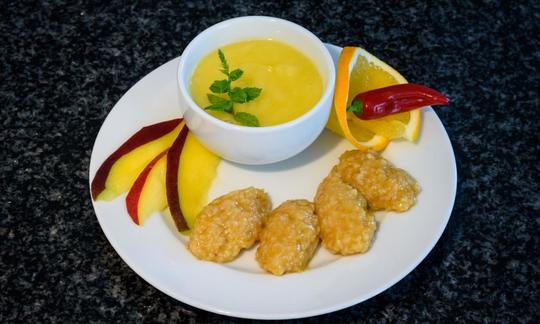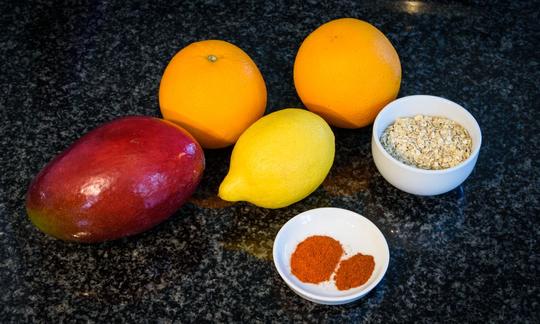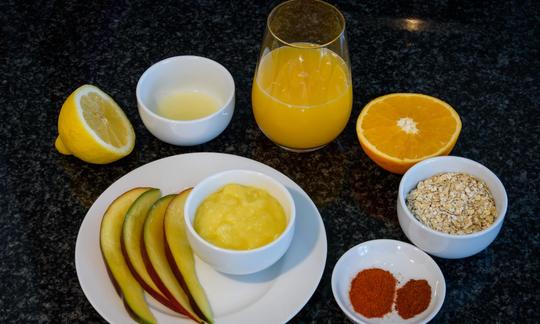Fiery orange-oat dumplings with mango-lemon sauce
vegan
Ingredients (for servings, )
| For the orange-oat dumplings | |
|---|---|
| 200 ml | Orange juice (raw?, organic?) (7.4 oz) |
| 1 oz | Oat flakes (raw?, organic?) |
| ½ tsp | Brown sugar (raw sugar, whole cane sugar, whole sugar, organic?) (0.05 oz) |
| 1 dash | Table salt (table salt, raw?, organic?) (0.01 oz) |
| ⅛ tsp | Chili powder (raw?, organic?) (0.01 oz) |
| ⅛ tsp | Paprika powder, hot (raw?, organic?) (0.01 oz) |
| For the mango-lemon sauce | |
| 10 ml | Lemon juice (raw?, organic?) (0.36 oz) |
| 4 ½ oz | Mangos, raw (organic?) |
Equipment
- hand-held blender / immersion blender
- stove
- citrus juicer (lemon squeezer)
- saucepan
Type of preparation
- squeeze
- bring to a boil
- purée
Preparation
For the orange-oat dumplings
Squeeze the oranges. Bring the orange juice and oat flakes to the boil, stirring, until the mixture reaches a slightly firm consistency, then add salt and brown sugar.If you want it to go faster, you can also use ready-squeezed orange juice.
Halve the mixture and season one half with chili and the other with paprika.
It is best to add chili and paprika powder very carefully at first. You can easily add more spice.
Allow the mixture to cool. Use 2 teaspoons to scoop out dumplings.
When cutting the dumplings, dip the teaspoons in hot water so that the mixture does not stick to the spoons.
For the mango-lemon sauce
Squeeze the lemon. Then puree the mango and lemon juice.If the mango is not quite ripe, you can add half a teaspoon of brown sugar to sweeten it.
serving
Serve the orange-oat dumplings on dessert plates and serve the mango-lemon sauce for dipping.
|
Nutritional Information per person
Convert per 100g
|
2000 kcal | |
|---|---|---|
| Energy | 146 kcal | 7.3% |
| Fat/Lipids | 1.5 g | 2.1% |
| Saturated Fats | 0.26 g | 1.3% |
| Carbohydrates (inc.dietary fiber) | 32 g | 11.7% |
| Sugars | 18 g | 20.4% |
| Fiber | 2.8 g | 11.4% |
| Protein/Albumin | 3.3 g | 6.6% |
| Cooking Salt (Na:85.3 mg) | 217 mg | 9.0% |
| Essential micronutrients with the highest proportions | per person | 2000 kcal | |
|---|---|---|---|
| Vit | Vitamin C (ascorbic acid) | 77 mg | 96.0% |
| Vit | Vitamin B9, B11 (Folate, as the active form of folic acid) | 64 µg | 32.0% |
| Min | Manganese, Mn | 0.60 mg | 30.0% |
| Elem | Potassium, K | 382 mg | 19.0% |
| Min | Copper, Cu | 0.18 mg | 18.0% |
| Vit | Vitamin B1 (Thiamine) | 0.18 mg | 17.0% |
| Prot | Tryptophan (Trp, W) | 0.04 g | 15.0% |
| Elem | Phosphorus, P | 89 mg | 13.0% |
| Sodium, Na | 85 mg | 11.0% | |
| Elem | Magnesium, Mg | 39 mg | 10.0% |
Detailed Nutritional Information per Person for this Recipe
The majority of the nutritional information comes from the USDA (US Department of Agriculture). This means that the information for natural products is often incomplete or only given within broader categories, whereas in most cases products made from these have more complete information displayed.
If we take flaxseed, for example, the important essential amino acid ALA (omega-3) is only included in an overarching category whereas for flaxseed oil ALA is listed specifically. In time, we will be able to change this, but it will require a lot of work. An “i” appears behind ingredients that have been adjusted and an explanation appears when you hover over this symbol.
For Erb Muesli, the original calculations resulted in 48 % of the daily requirement of ALA — but with the correction, we see that the muesli actually covers >100 % of the necessary recommendation for the omega-3 fatty acid ALA. Our goal is to eventually be able to compare the nutritional value of our recipes with those that are used in conventional western lifestyles.
| Essential fatty acids | per person | 2000 kcal |
|---|---|---|
| Linoleic acid; LA; 18:2 omega-6 | 0.40 g | 4.0% |
| Alpha-Linolenic acid; ALA; 18:3 omega-3 | 0.06 g | 3.0% |
| Essential amino acids | per person | 2000 kcal |
|---|---|---|
| Tryptophan (Trp, W) | 0.04 g | 15.0% |
| Threonine (Thr, T, irreversibly transaminated) | 0.09 g | 9.0% |
| Valin (Val, V) | 0.14 g | 9.0% |
| Isoleucine (Ile, I) | 0.10 g | 8.0% |
| Leucine (Leu, L) | 0.19 g | 8.0% |
| Lysine (Lys, K, irreversibly transaminated) | 0.15 g | 8.0% |
| Phenylalanine (Phe, F) | 0.13 g | 8.0% |
| Methionine (Met, M) | 0.04 g | 4.0% |
| Vitamins | per person | 2000 kcal |
|---|---|---|
| Vitamin C (ascorbic acid) | 77 mg | 96.0% |
| Vitamin B9, B11 (Folate, as the active form of folic acid) | 64 µg | 32.0% |
| Vitamin B1 (Thiamine) | 0.18 mg | 17.0% |
| Vitamin B6 (pyridoxine) | 0.14 mg | 10.0% |
| Vitamin B5 (Pantothenic acid) | 0.50 mg | 8.0% |
| Vitamin B3 (Niacin) | 1.0 mg | 7.0% |
| Vitamin E, as a-TEs | 0.78 mg | 7.0% |
| Vitamin B2 (Riboflavin) | 0.08 mg | 6.0% |
| Vitamin A, as RAE | 50 µg | 6.0% |
| Vitamin B7 (Biotin, ex vitamin H) | 3.0 µg | 6.0% |
| Vitamin K | 3.3 µg | 4.0% |
| Essential macroelements (macronutrients) | per person | 2000 kcal |
|---|---|---|
| Potassium, K | 382 mg | 19.0% |
| Phosphorus, P | 89 mg | 13.0% |
| Sodium, Na | 85 mg | 11.0% |
| Magnesium, Mg | 39 mg | 10.0% |
| Calcium, Ca | 28 mg | 4.0% |
| Essential trace elements (micronutrients) | per person | 2000 kcal |
|---|---|---|
| Manganese, Mn | 0.60 mg | 30.0% |
| Copper, Cu | 0.18 mg | 18.0% |
| Selenium, Se | 4.9 µg | 9.0% |
| Iron, Fe | 1.0 mg | 7.0% |
| Zinc, Zn | 0.67 mg | 7.0% |
| Fluorine, F | 0.00 µg | < 0.1% |
| Iod, I (Jod, J) | 0.12 µg | < 0.1% |
Spicy desserts are a real treat. The fiery heat of the chili harmonizes perfectly with the fruity sweetness of the orange-oat dumplings and the mango-lemon sauce in this sophisticated recipe. The aromas of many exotic and local fruits also really come into their own with a hint of heat.
Vitamin C: Due to the mango and the liquid citrus fruits, this recipe has a high vitamin C content. However, vitamin C, like vitamin B1 ( thiamine) and vitamin B5 ( pantothenic acid), is one of the heat-sensitive vitamins. However, this plays a rather minor role here, as long as you only heat the orange juice and oat flake mixture briefly.
Oat flakes: Oat flakes have a high protein content and contain many essential amino acids. They are also rich in vitamins and minerals. Since conventional oat flakes are no longer strictly considered "raw food" due to heat and steam treatment, you can use oat flakes made from pre-germinated oats if necessary. The germination process used here makes the oat flakes more digestible and at the same time increases the bioavailability of their valuable ingredients.
Mangos: There are now over 1000 types of mango, which differ in shape, size and taste. Mangos are said to soothe the intestines because they are easy to digest and low in acid. Due to their high vitamin C content, mangos can be used as a preventative measure against infections and colds. You can tell when a fruit is ripe by the way it smells and gives slightly when pressed.
Orange juice: Orange juice, also known as OJ or orange juice, has a high vitamin C content. This is just over 50 mg in 100 ml, i.e. more than 50% of the recommended daily requirement according to the GDA recommendation. Orange juice is the most consumed juice in the world, with the lion's share of exports coming from Brazil. Despite its sometimes bitter taste, you should not add additional sugar, as the juice itself consists of almost 10% sugar.
Spiciness: The amount of chili or paprika powder to use depends on your sensitivity to spiciness and should therefore be dosed individually.
Sweetening: If you like it a little sweeter, you can increase the amount of sugar. However, the actual amount needed depends largely on the ripeness of the mango and the quality of the oranges.
Ripe mangos: If you want to be sure that you get a ripe fruit, choose so-called air-flight mangos - these are harvested ripe and flown in by plane. Ripe mangos are best consumed as soon as possible.
Fresh chili: You can add some fresh chili to the mango lemon sauce.








